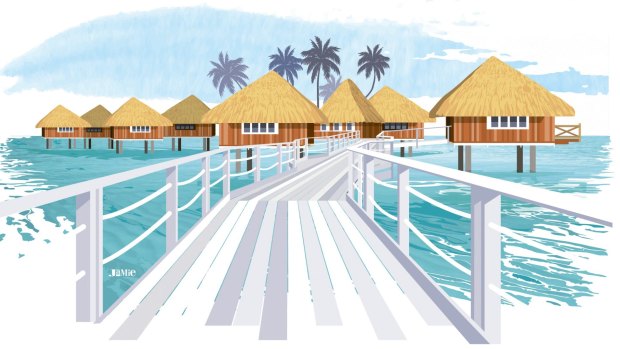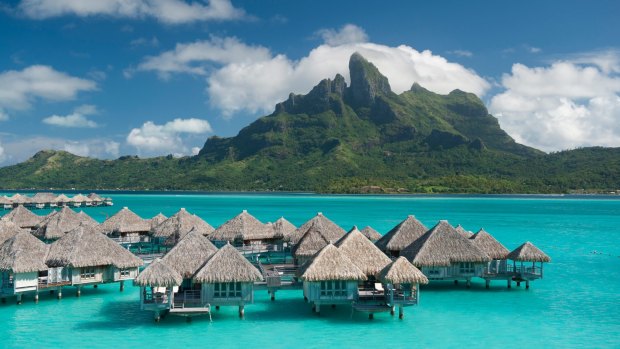This was published 4 years ago
Overwater bungalows: Excessively luxurious or the ultimate slice of paradise?

Illustration: Jamie Brown
During World War II, a popular if somewhat disdainful term was employed to describe the friendly invasion of Australian shores by well-remunerated American GIs: "over-sexed, overpaid and over here".
With some minor amendments, that phrase could also be applied to another largely benign incursion, that of a highly indulgent type of accommodation which also has American history. Said accommodation could be described as "over-priced, over-the-top and over-the-water".
I refer to the thatch-roofed overwater bungalows that have proliferated like twee paper cocktail umbrellas wherever suitably idyllic tropical islands, lagoons and reefs are to be found.

Overwater bungalows at the St Regis Bora Bora Resort.Credit: Tahiti Tourism
Thrust out over the shallow sea atop spindly concrete pylons – like fully extended human palms – they create the illusion of being adrift on the ocean and give their occupants direct access to the water, for snorkelling and swimming.
Far from being an authentic tribute to traditional islander housing, however, the overwater bungalow was actually invented by three canny Californians known as the Bali Hai Boys.
Their first effort was on the notably beach-free but reef-rich French Polynesian island of Raiatea, about 15 minutes by air from Bora Bora, but in many ways a world away from it.
Fifty years later, this excessively luxurious form of recreational reclamation has spread elsewhere in French Polynesia as well as to the Maldives, the Caribbean, southeast Asia and Fiji. All that is required is the merest speck of an atoll around which to drape your elevated timber and concrete necklace. .
But a collection of thatched roofs and a bunch of stilts was never going to be enough to satisfy the affluent, ever-demanding international traveller. Thus it became de rigeur to have a glass panel in the floor of the bungalow, preferably in the living room, through which to view the marine life passing below. In French Polynesia, this became known as "Tahitian TV". .
At Likuliku Resort in Fiji there's even a glass floor panel that extends the length of the bathroom so guests can, as they undertake their daily ablutions, observe the Technicolor fish below.
Then there are the resorts where overwater bungalows surrounded only by crystalline seas have been deemed insufficient and the addition of a built-in chlorinated plunge pool deemed necessary.
At the Conrad Hilton Bora Bora Nui Resort, a single-storey overwater bungalow is inadequate. A second floor is required to entice well-heeled celebrities such as Nicole Kidman and Keith Urban. With two bedrooms, three bathrooms, dressing rooms and several of those glass-floor viewing panels, the Conrad Hilton's Presidential Overwater Villa is several times larger than my own (fully-grounded and completely snorkelling-free) inner-Sydney bungalow.
There are now an estimated 7000 overwater bungalows around the palm-fringed tropical world, though not all are as grandiose as Nicole and Keith's. It seems an atoll is scarcely an atoll at all these days without its own necklace of floating bedrooms.
Sign up for the Traveller Deals newsletter
Get exclusive travel deals delivered straight to your inbox. Sign up now.